|
|

The purchaser of the lot asked me to do some research on the cover in an effort to either establish its authenticity or refute it unequivocally.
I will commence with a physical description of the cover. It is an envelope addressed to Mr. John MacDonald at West Chester, Pennsylvania to the care of Mr. A Balmer (sp?). It is endorsed across the top "Via Vera Cruz y(and) N(ew) O(rleans) E(stados) U(nidos)". It bears a Mexico 1 real adhesive stamp tied together with a United States 10c stamp by blue "Parral" boxed cancel. A manuscript date of November 17th additionally ties the Mexican adhesive at left. It entered the United States mails in New York City as a private ship letter on February 4th and was rated 5 cents due. There is nothing on the reverse of the cover other than a pencil note that it is ex Richey collection.
The first record of the cover I find was that it was illustrated on page 262 of volume 2 of Stanley Ashbrook's "The United States One Cent Stamp Of 1851-1857" published in 1938. Ashbrook comments:
"The cover illustrates a letter originating in Mexico. The use is subsequent to April 1, 1855. The writer probably intended it to travel to West Chester, Pa., via Vera Cruz and New Orleans but it went by private ship to New York where it was postmarked with the "New York-Ship-5cts" in black, indicating 5c was due on delivery. The 10c 1855 on this cover was not recognized when the letter reached the New York Post Office, as it was applied and cancelled outside of the U.S. before it reached New York."
My first question, assuming for a moment that the cover is genuine, is how did it actually travel and what postal rates were applicable. My first step was to try to determine the year of usage. In "Mexican Maritime Mail" by Schimmer and Heath, on page 183, I found an illustration of the cover below. It is a usage from Mexico City to Canada that entered the United States mail on February 4, 1857.
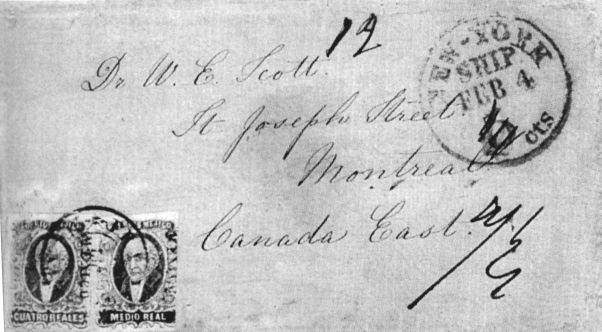
The New York ship marking is identical to that on the combination cover under study. So, the date of usage was established as November 17, 1856 from Parral and that it entered the United States mails in New York City as a ship letter on February 4, 1857.
The question arises as to why the cover bears a United States 10c stamp on it. The postal rate to the United States in 1856 was 10c, so it is possible that the sender intended the stamp to pay the United States rate even though such was not allowable. The stamp was, in effect, superfluous.
It is presumed that the cover was intended to travel as directed by the sender's instructions. This would have been the normal routing for a cover from the Mexican interior to the United States when steamship service was in operation. According to the Mexican postal tariffs that went into effect on July 15, 1856, the postal rate for carriage of a one-half ounce letter from Parral to Vera Cruz was 1½ reales (see Schimmer and Heath, page 381). The cover only bears prepaid postage of 1 real and there is no postage due handstamp. The postmaster at Parral was using handstamped due indications during this period as can be seen from the "2" reales handstamp on the 1855 cover shown below.
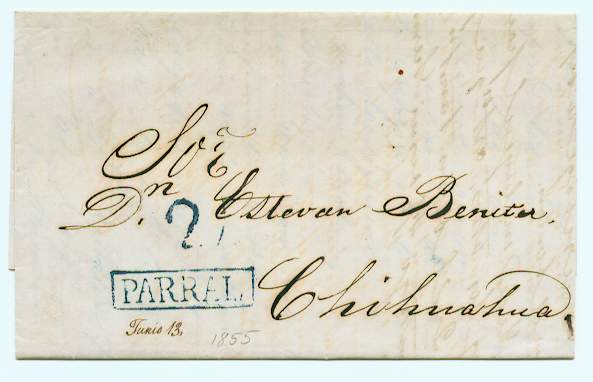
The only rate that would correspond to the one real franking in November, 1856 was for a letter that was to be carried a distance of no more than 30 leagues. Parral was located a distance of over 200 leagues from Vera Cruz. The one real franking does not correspond to any possible rate from Parral to either coast during any of the rate periods in effect in Mexico before 1864.
This is the first anomaly of the cover. The only ways to explain this that preserve the cover's authenticity, is that the postmaster either made a mistake, or that the cover was carried out of the mails from Parral by a private carrier. There is no evidence of any private carriage.
Another potential problem with the cover was the long delay between date of posting and the date of arrival in New York City. I found that there was no contract steam ship service in place in November, 1856 due to the lapse of the contract. I was unable to find any covers posted from Mexico to the United States that were posted between November 17, 1856 and February, 1857. My conclusion is that the cover did travel from Parral to Vera Cruz and was held at Vera Cruz until a private ship bound for the United States could be found. Covers from this general period that were carried by contract steamers from Vera Cruz usually show a Vera Cruz backstamp.
I then began to evaluate the physical evidence on the cover. I found an example of the Parral cancel on an adhesive as well as a tracing of the strike. Both are shown below.
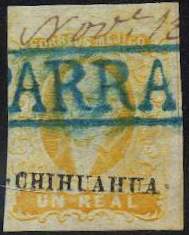

Note that the manuscript month indication on the stamp is identical to the handwriting that appears on the combination cover and that the pale watery blue ink is also identical. If the postmark is correct on the combination cover, as it appears to be in reference to at least the one real stamp, I assume that portion of the cover is genuine.
Close physical examination of the postmark lead me to suspect that at least part of the Parral cancel had been doctored. The difference in appearance in the blue ink between the cancel on the Mexican stamp and on the United States stamp is visible with the naked eye. The United States stamp also bears manuscript cancels in two distinctly different inks. Neither seems an exact match to the ink of the date marking.
The high resolution scan (originally performed at 1200 dpi) below confirms these suspicions as it shows abnormalities in the second letter "A" of the cancel, especially the cross stroke that looks like it was done freehand rather than being a straight line. This indicates the likelihood of a painted cancel. The portion of the cancel that looks retouched also appears to be a different shade of blue. The "jump" strike of the cancel is a most unusual feature.
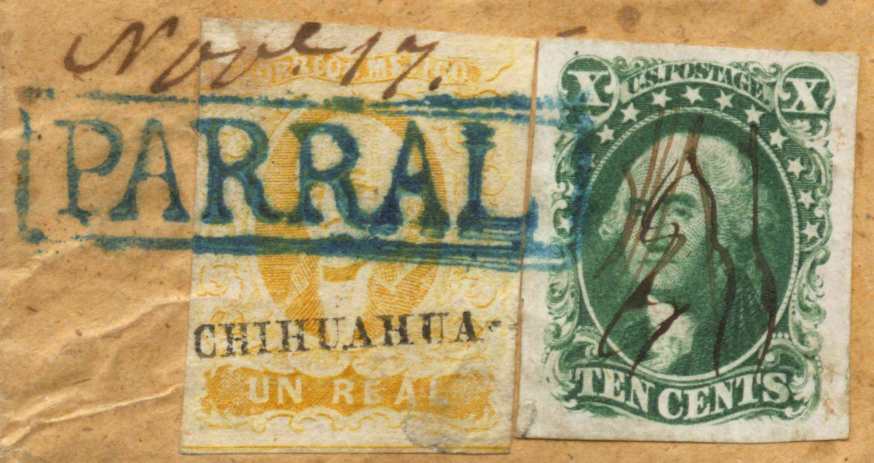
I then did a simple "replace color" command using Corel Photo-Paint 8 image editing program. I replaced the blue color found on the suspect crossbar portion that looked repainted, with red. The stunning results are shown below.
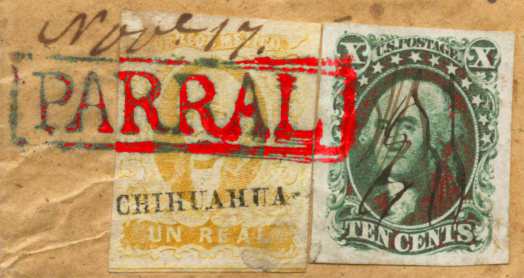
Only red appears on the United States stamp and the mixed red and blue ends abruptly at the edge of the Mexican stamp. It is very clear from this that the portion of the cancel that appears on the United States stamp is different from the underlying cancel that appears on the Mexican adhesive. This finding is consistent with the over-painting of the cancel on the Mexican stamp and painting in to extend it to the United States stamp. Also, the "jump" portion of the strike is largely repainted. This is not shown as any kind of scientific proof, but rather as an example of how existing technology can often be used to confirm visual evidence.
The unavoidable conclusion is that a Mexican stamp (probably a one-half real stamp) was originally positioned where the United States stamp is now. Assuming that to be the case, everything else about the cover fits. The two Mexican stamps prepaid the postage from Parral to Vera Cruz where the postmaster had to turn the cover over to a private ship for carriage to New York City because there was no contract steamer service available.
In summary, it is my opinion that the United States stamp did not originate on this cover. The stamp was substituted for the Mexican stamp that was originally on the cover and the tie was painted on.
I would like to thank several members of the MEPSI group that responded to my requests for assistance and reference materials. Particular thanks to Monte Hensley, John Kordich, Doug Stout, Nick Follansbee and Salomon Rosenthal. The above is my opinion only and does not necessarily reflect that of any of those named above.
In addition, I should note that the other 10c combination cover that Ashbrook mentions is not from the same correspondence. That cover bears a 4r Mexico stamp and is used from Mexico City, via Steamship, to Charleston. A 1947 note from Ashbrook notes that the subject cover discussed here is likely the cover sold in a Morgenthal auction held in 1910.
Also, I show below a picture of the item taken using a black light. Although not as conclusive when photographed as it appears to the naked eye, it also clearly shows that something is different in the ink that appears on the two stamps.
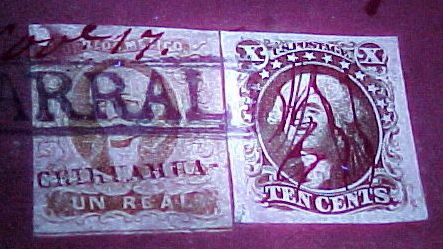
Richard Frajola (October 5, 2000)


